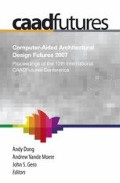The virtual reality (VR) generated by computer graphics (CG) has developed very rapidly in accordance with the rapid improvement of computer hardware and CG algorithms. Not only visual still images but also the representation of the behavior of virtual objects has became possible owing to real-time physics simulation, which can provide a high sense of presence to users. Adopting the real-time physics simulation and the force-feedback interface to the architectural design process in VR could make it more realistic by providing a sense of virtual objects such as the weight of the mass, tactile sensation, and interaction between virtual objects and users. As a pilot application of real-time physics simulation and the forcefeedback interface in the architectural field, we are developing an educational VR system for earthquake disaster preparedness through a room re-layout design process.
Access this chapter
Tax calculation will be finalised at checkout
Purchases are for personal use only
Preview
Unable to display preview. Download preview PDF.
References
Architectural Institute of Japan: 1996, Report of Damage Occurring Inside of Houses at Hanshin-Awaji Great Earthquake, AIJ (Japanese).
Bimber, O, Emmerling, A, and Klemmer, T: 2005, Embedded Entertainment with Smart Projectors, IEEE Computer 38(1): 56-63.
Bliss, JP and Tidwell, PD: 1997, The Effectiveness of Virtual Reality for Administering Spatial Navigation Training to Firefighters, Presence 6(1): 73-86.
Buoguila, L, Cai, Y, and Sato, M: 1997, New Haptic Device For Human Scale Virtual Environment: Scaleable-SPIDAR, ICAT’97, Tokyo, pp. 93-98.
Cruz-Neira, C, Sandin D, and DeFanti, T: 1993, Surround-Screen Projection-Based Virtual Reality: The Design and Implementation of the CAVE, Proceedings of ACM SIGGRAPH’93, pp. 135-142.
Hill II, LC, Chan, C-S, and Cruz-Neira, C: 1999, Virtual Architecture Design Tool (VADeT), Third International Immersive Projection Technology Workshop (IPT 1999).
Hirose, M, Ogi, T, Ishiwata, S, and Yamada, T: 1998, Development and Evaluation of Immersive Multiscreen Display “CABIN”, The transactions of the Institute of Electronics, Information and Communication Engineers D-II J81(5): 888-896.
Ishii, M and Sato, M: 1994, A 3D Spatial Interface Device Using Tensed Strings, Presence: Teleoperators and Virtual Environments 3(1): 81-86.
Leigh, J, Johnson, A, Vasilakis, C, and DeFanti, T: 1996 Multi-perspective Collaborative Design in Persistent Networked Virtual Environment. Proceedings of IEEE Virtual Reality Annual International Symposium’96, pp. 253-260.
Masuda, H, Midorikawa, S, Miki, C, and Ohmachi, T: 1988, Formative Process of Consciousness of Earthquake Preparedness and Evaluation of Effects of Earthquake Education, Journals of the Japan Society of Civil Engineers 398(I-10):359-365. (Japanese)
Rohrmann, B: 2000, A socio-psychological Model for Analyzing Risk Communication Process, The Australasian Journal of Disaster and Trauma Studies, 2000-2, http://www.massey.ac.nz/∼trauma/issues/2000-2/rohrmann.htm.
Ryu, J, Hasegawa S, Hashimoto N, and Sato M: 2004, Multi-Projection Display System for Architectural Design Evaluation, The 9th Conference on Computer-Aided Architectural Design Research in Asia (CAADIRA), pp. 901-910.
Shaw, R, Shiwaku, K, and Kobayashi, H: 2004, Study on New System of Earthquake Disaster Education at High School (-analysis of factors affecting awareness in questionnaire survey targeted for high school students-), Journal of Environment Engineer AIJ , 585: 69-74 (Japanese).
Takimoto, K, and Miura, F: 1999, Development of Earthquake Preparedness Education Software for an Elementary and Junior High School Students and Its Evaluation, Journals of the Japan Society of Civil Engineers 619(I-47): 155-167 (Japanese).
http://www.dri.ne.jp/index.html: Disaster Reduction and Human Renovation Institution of Kobe City. http://www.disastereducation.org: The National Disaster Education Coalition(NDEC) of USA. http://www.tfd.metro.tokyo.jp/ts/museum.htm: Fire Museum of Japan & Disaster preparedness Center. http://www.uni-weimar.de/medien/ar/sARc/index.htm.
Author information
Authors and Affiliations
Editor information
Editors and Affiliations
Rights and permissions
Copyright information
© 2007 Springer
About this paper
Cite this paper
Ryu, J., Ohno, R. (2007). A Novel Room Re-Layout Design Tool for Preparedness of Earthquake Disaster Using Real-Time Physics Simulation and Force-Feedback Interface. In: Dong, A., Moere, A.V., Gero, J.S. (eds) Computer-Aided Architectural Design Futures (CAADFutures) 2007. Springer, Dordrecht. https://doi.org/10.1007/978-1-4020-6528-6_40
Download citation
DOI: https://doi.org/10.1007/978-1-4020-6528-6_40
Publisher Name: Springer, Dordrecht
Print ISBN: 978-1-4020-6527-9
Online ISBN: 978-1-4020-6528-6
eBook Packages: Architecture and DesignEngineering (R0)

